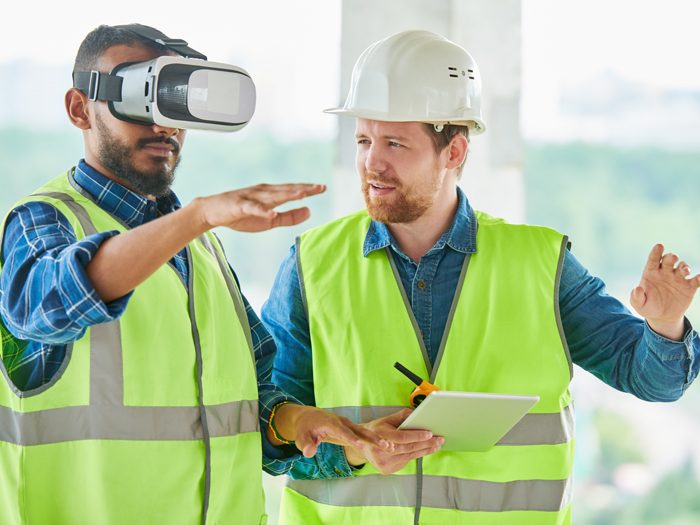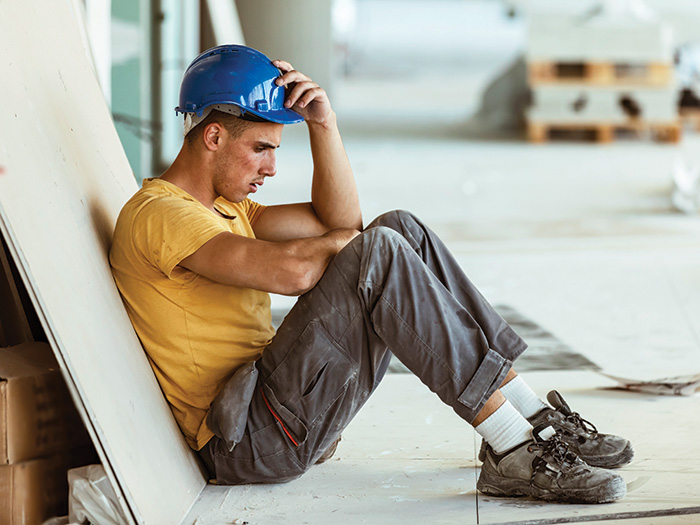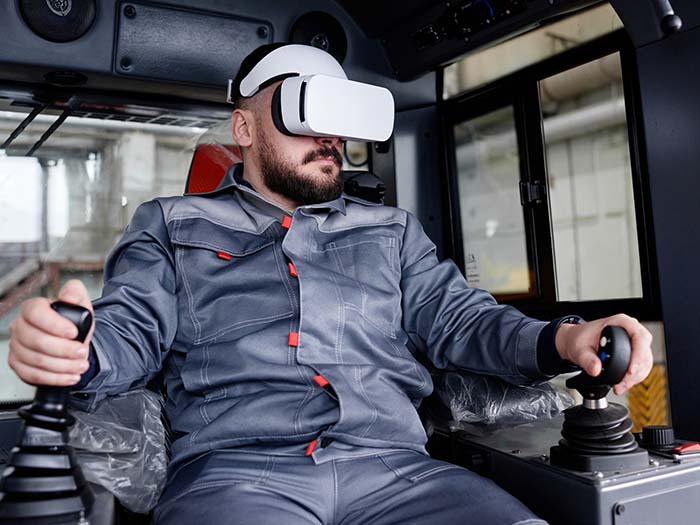These Are the Top 5 Technologies Starting to Make Construction Safer

Construction workers are typically skeptical of new technologies promising to make their jobs easier. Why?
“People are fearful of losing their jobs to automation. They feel that if a robot or computer can do part of the job, they become more dispensable,” said Tom Boudreau, Senior Vice President Middle Market with The Hartford. “However, we think that is a generational issue. We are seeing some change in the acceptance of new technology that can improve job site safety. The shift enables us to see a brighter future as far as preventing injury and getting workers home safely every night.”
Here are the five technologies that could lead to critical improvements in worker safety as they gain acceptance on the job site:
1. Exoskeletons
Exoskeletons range from simple upper body supports all the way to full-body suits, but all can assist with a variety of physically demanding tasks.
“Many of the suits out there assist with heavy lifting and can make loads feel a little lighter,” Boudreau said. Others ease the cumulative musculoskeletal burden of repetitive motions, which contribute to soft-tissue injuries.
For this reason, exoskeletons have been more prevalent in manufacturing, where repetitive tasks like riveting and drilling are common jobs.
“People on manufacturing lines are doing the same work every day, using the same hand and arm motions, which is why we’ve seen greater adoption of exoskeletons in that sector,” Boudreau said. “Now we’re trying to educate the construction industry on how this technology can apply to their specific needs.”
Subcontractors doing exterior finishing work, for example, could benefit from extra support for arms and shoulders that are extended for long periods of time.
2. Wearables
Wearables have evolved far beyond wristwatches and clip-on GPS trackers.
“All kinds of wearable equipment have come light years from initial iterations,” Boudreau said. “There are goggles now that can record and transmit in real time what the worker is seeing to someone miles and miles away. This means the worker can get advice from a supervisor instantaneously, which reduces the risk of error but also ensures that the worker is performing the function safely.”
Smart vests and boot inserts can also monitor a worker’s heart rate, body temperature and sweat rate, which can allow a potentially dangerous situation like heat stroke to be spotted and remediated before an injury occurs. Motion sensors detect when a worker has fallen or perhaps hasn’t moved at all for a period of time, and can alert supervisors or nearby colleagues.
“The technology is advanced enough that it can detect whether a worker has simply stopped in place, has taken off the device, or has actually slipped and fallen,” Boudreau said.
Wearables also have training applications that enhance safety from a proactive rather than reactive perspective. Amid construction’s ongoing labor shortage, finding the time and resources to train new workers is challenging, but wearable devices that provide a real-time view of a job allows managers or other senior workers to make corrections before a trainee gets injured or makes a mistake.
“This is an opportunity to become a lot more efficient while also improving safety,” Boudreau said.
3. Virtual Reality Simulators
In the same vein, virtual reality training programs expose new employees to tricky or potentially dangerous situations before they encounter them in real life.
“For the last decade or so, there’s been declining investment in training new contractors due to the labor shortage. There’s decreased availability of senior people to train new workers, and project owners need new hires on the job quickly,” Boudreau said.
“When pilots learn to fly, they don’t just jump in a plane and go. They practice in a flight simulator. Contractors can similarly test their reactions in dangerous situations with the help of VR.” – Tom Boudreau, Senior Vice President Middle Market, The Hartford
Virtual reality simulations provide “hands-on” experience without the threat of danger, so trainees can make mistakes and learn from them in a safe environment. Boudreau likened it to pilot training.
“When pilots learn to fly, they don’t just jump in a plane and go. They practice in a flight simulator. Contractors can similarly test their reactions in dangerous situations with the help of VR,” he said.
Investment in virtual reality simulators are well worth the return; getting contractors together in one site for training can be time-consuming and cost prohibitive, and VR removes the location barrier.
4. Robots and Automated Machinery
Remote-controlled robots are gaining traction for their advantages in the dangerous work of demolition. “Losing a robot, obviously is much easier to digest than losing a person,” Boudreau said. But robots can also perform, to some degree, the more arduous tasks of building.
“Semi-automated brick-laying machines, for example, can build at a rate equivalent to four human workers,” Boudreau said. “3D printers, which I also consider to be a form of robotic building, can also synthesize components.”
Though this taps into the fear that automation will eliminate jobs, Boudreau emphasized that such machinery should be seen as an aid to the human worker to maximize his or her efficiency, not a replacement.
“If you have a machine that’s doing the heavy lifting, you allow contractors to devote more time and energy to finer work that requires craftsmanship,” Boudreau said.
5. Site Sensors
Environmental sensors detect temperature, humidity, pressure, dust particles and smoke throughout a job site, and send real-time alerts if something goes awry. Often battery-powered and operating using cellular data, site sensors require no additional infrastructure and take up almost so space, but they can prove critical in mitigating professional liability, construction defect and safety risks.
Factors like moisture or particulate matter that imperil a building’s structural integrity or safety over time can be caught and addressed early, eliminating costly claims in the future.
“If water leakage or potential mold growth happens after a building’s been completely enclosed, there could be long term ramifications. Fixing that means ripping out walls and changing HVAC systems. In large, multi-story buildings, that can amount to millions in losses,” Boudreau said.
Site sensors equipped with alarms can also alert workers of an emergency more quickly and speed up evacuation time.
While adoption of these technologies has been slow in the construction industry, Boudreau said “I’m bullish enough to believe we will see these tools grow more prominent, and that they will yield significant safety improvements.” &











